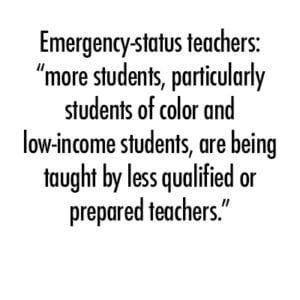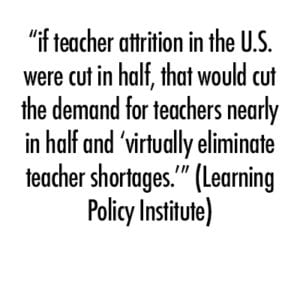Teacher shortages are no doubt a problem for a number of reasons, but are we clear about what’s causing them? How do teacher training and larger workforce realities play into it? Is teaching all that different from other career paths in terms of attrition? If it is and we do have trouble holding on to quality educators, I think a bit of introspection is in order.
 According to a recent Learning Policy Institute (LPI) report, A Coming Crisis in Teaching?, the U.S. is facing a teacher supply and demand problem, leading to a shortage of teachers. Why are teacher shortages a problem? First of all, shortages lead to an inability of schools to fill vacancies with qualified educators. In California, for example, the number of emergency and temporary teaching permits has tripled within the last three years, and over a third of the credentials and permits issued for the 2014-15 school year went to teachers not fully prepared for their teaching assignments.
According to a recent Learning Policy Institute (LPI) report, A Coming Crisis in Teaching?, the U.S. is facing a teacher supply and demand problem, leading to a shortage of teachers. Why are teacher shortages a problem? First of all, shortages lead to an inability of schools to fill vacancies with qualified educators. In California, for example, the number of emergency and temporary teaching permits has tripled within the last three years, and over a third of the credentials and permits issued for the 2014-15 school year went to teachers not fully prepared for their teaching assignments.
There’s also an equity component: these teachers are more likely to serve low-income students and students of color. According to LPI, teachers working on emergency credentials were three times more likely to serve in high-poverty, high-minority schools than in low-poverty, low-minority schools, and high-minority schools had four times as many uncertified teachers as low-minority schools. That means more students, particularly students of color and low-income students, are being taught by less qualified or prepared teachers.
Is Attrition to Blame for Teacher Shortages?
Clearly teacher shortages are problematic, so what’s causing them? Part of the story is that teacher supply is shrinking. Between 2009 and 2014, enrollments in teacher preparation programs fell by 35 percent and teacher preparation graduates fell by 23 percent, meaning fewer teachers are entering the field. Teacher demand is also growing, due in part to increasing student enrollments and decreasing student-teacher ratios.
 However, another important trend is at work: teacher attrition. Teacher attrition – the rate at which teachers leave the profession – is at 8 percent annually, which is about twice as high as rates in high-achieving countries like Finland, Singapore, and Canada. Moreover, pre-retirement attrition accounts for two-thirds of teacher turnover, meaning the majority of teachers could continue their career in the classroom. According to LPI, if teacher attrition in the U.S. were cut in half, that would cut the demand for teachers nearly in half and “virtually eliminate teacher shortages.”
However, another important trend is at work: teacher attrition. Teacher attrition – the rate at which teachers leave the profession – is at 8 percent annually, which is about twice as high as rates in high-achieving countries like Finland, Singapore, and Canada. Moreover, pre-retirement attrition accounts for two-thirds of teacher turnover, meaning the majority of teachers could continue their career in the classroom. According to LPI, if teacher attrition in the U.S. were cut in half, that would cut the demand for teachers nearly in half and “virtually eliminate teacher shortages.”
But this solution to the teacher supply and demand problem is easier said than done. According to Linda Darling-Hammond, LPI President and CEO, “retaining teachers is a far larger problem than recruiting new ones.” In another recent report, Solving the Teacher Shortage, LPI lays out the most common reasons why teachers leave the profession and provides federal, state, and local policy recommendations for attracting and retaining strong teachers.
While I don’t disagree that retaining more teachers would help address the problem of teacher shortages, I wonder about general workforce turnover trends, the role of alternative credentialing programs, and the reality that many folks currently working in education – whether in policy, research, or administration – started their careers in the classroom and left before retirement age. What else could be causing this attrition, and what are some other factors that we should consider?
Workforce Turnover
How does teacher attrition compare to worker attrition more broadly? If 8 percent is a high teacher turnover rate, how does it compare to other professions? Millennials are often accused of being job-hoppers and, by 2020, nearly half of the U.S. workforce will be comprised of millennials. According to Gallup, millennials “are the generation in the workplace most likely to look for and change jobs.” Moreover, the average employee tenure in 2016 was 4.2 years according to data from the Bureau of Labor Statistics. Can turnover in the teaching profession in part be explained by larger workforce trends? If so, how should addressing teacher attrition acknowledge the realities of the changing workforce?
Alternative Credentialing Programs
How do alternative teacher certification programs like Teach for America (TFA), which require a two-year commitment from corps members to teach in low-income urban and rural schools, contribute to teacher attrition? TFA is not the only alternative teacher credentialing program, but it’s low retention has been a major point of criticism. According to TFA, 88 percent of their first-year teachers return for a second year. However, a 2015 report by Mathematica Policy Research found that 87 percent of TFA teacher say they “do not plan to spend the rest of their career as a classroom teacher,” compared to 26 percent of non-TFA teachers. How much of teacher turnover can be attributed to programs like TFA? If it’s sizable, how might efforts to address teacher attrition confront this reality?
Former Educators
 In the education policy world, I often feel I’m in the minority for not having teaching experience. I don’t know if that’s actually true, but it wouldn’t be surprising if it were – people are likely to be passionate about working and making an impact in education because of experiences they had in the classroom. Sometimes I wonder if this makes me a weaker advocate or if I’m respected less in the field. But, in thinking about teacher attrition, I realized something: we would not really want all teachers to stay in the profession until retirement. If we did, we would not appreciate the work and value the expertise of the many school, district, and state education leaders, researchers, and policy wonks that started their careers teaching.
In the education policy world, I often feel I’m in the minority for not having teaching experience. I don’t know if that’s actually true, but it wouldn’t be surprising if it were – people are likely to be passionate about working and making an impact in education because of experiences they had in the classroom. Sometimes I wonder if this makes me a weaker advocate or if I’m respected less in the field. But, in thinking about teacher attrition, I realized something: we would not really want all teachers to stay in the profession until retirement. If we did, we would not appreciate the work and value the expertise of the many school, district, and state education leaders, researchers, and policy wonks that started their careers teaching.
We would not say the Linda Darling-Hammonds, Randi Weingartens, and John Kings of the world should have never left the classroom. Not because they are not good educators (which perhaps is a valid reason to leave the profession), but because their leadership and contributions to education research and policy are also great and important for improving education.
Retaining teachers is important for addressing the teacher shortage, but is some turnover desirable? How do we strike a balance between “elevating the teaching profession,” recruiting and retaining strong teachers, and ensuring there’s opportunities to grow within and beyond the profession?
Jenna Tomasello is a Policy Associate at the American Youth Policy Forum.




